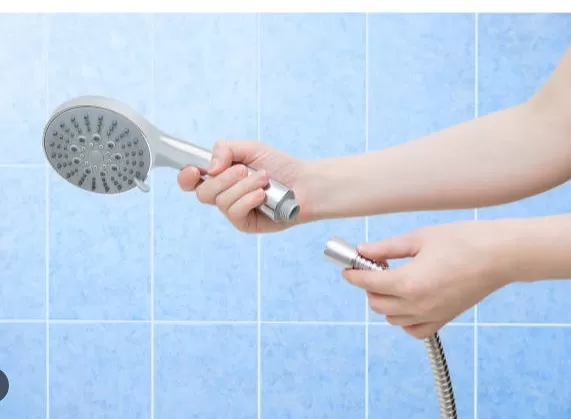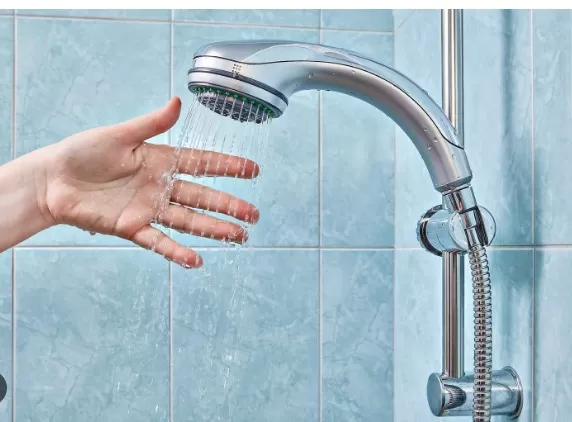Shower Head Cleaning: Step-by-Step Guide. Regularly cleaning your shower head is essential to maintain a strong and invigorating water flow. Over time, minerals present in the water can accumulate and clog the tiny holes in the shower head, resulting in a weak or uneven spray.
If you’re disappointed with a lackluster shower experience, it’s likely that your shower head needs cleaning to remove the scaly buildup and restore its flow strength. Thankfully, cleaning a shower head is a simple task that yields satisfying results. Start by detaching the shower head from the pipe, if possible, and submerge it in a solution of vinegar and water. Let it soak for a while to dissolve the mineral deposits. Next, use a brush or toothbrush to scrub away any remaining buildup. Rinse the shower head thoroughly and reattach it to the pipe. You’ll be delighted with the improved water flow and the rejuvenating shower experience that follows. By investing a small amount of time in cleaning your shower head, you’ll ensure it performs at its best.
The Scrubbing Method: An Effective Solution for Removing Scale Buildup from Shower Heads
Maintaining a clean and functioning shower head is essential for a refreshing shower experience.
Over time, shower heads can develop mild scale buildup and hard water stains, diminishing their performance. However, there is a simple and effective solution to this problem: the scrubbing method. In this article, we will explore how this method can help remove scale buildup and restore the efficiency of your shower head.
Understanding the Problem
The effects of scale buildup: Scale buildup can restrict water flow and affect the spray pattern of the shower head, leading to reduced water pressure and an unsatisfactory showering experience.
Identifying mild scale buildup: Mild scale buildup is characterized by the formation of hard water stains on the face of the shower head, particularly around the water holes.
The Scrubbing Method
Gathering the necessary materials: To implement the scrubbing method, you will need a suitable cleaner and a small scrubber with nylon bristles.
Choosing an appropriate cleaner: Select a cleaner specifically designed to dissolve deposits and remove scale buildup.
It should be safe for use on shower heads and compatible with the materials used in their construction.
Preparing the shower head: Before starting the scrubbing process, turn off the water supply to the shower head and detach it from the shower arm, if possible.
Applying the cleaner: Apply the chosen cleaner to the face of the shower head, focusing on the areas with scale buildup.
Allow the cleaner to penetrate and dissolve the deposits for the recommended duration.
Scrubbing the shower head: Using a small scrubber with nylon bristles, gently scrub the face of the shower head.
Pay attention to the tiny nooks and crannies where scale buildup may accumulate. Apply moderate pressure to effectively remove the deposits without causing damage to the shower head.
Rinsing and reattaching: After scrubbing, thoroughly rinse the shower head with Clean Water to remove any remaining cleaner and loosened deposits.
Reattach the shower head to the shower arm and turn on the water supply to test its performance.
Preventive Measures
Regular cleaning routine: To prevent scale buildup, incorporate regular cleaning of the shower head into your household cleaning routine.
Water softening methods: Consider using water softening methods or installing a water softener system to minimize the accumulation of hard water deposits.
Protective measures: Utilize a shower head filter or vinegar soak periodically to further prevent scale buildup and maintain the efficiency of your shower head.
Advantages of Using the Scrubbing Method for Cleaning Shower Heads

Effectiveness: The scrubbing method is highly effective in removing light soap scum and deposits from shower heads.
It can help restore the water flow and improve the overall performance of the shower head.
Versatility: This method is suitable for both stationary shower heads attached to a shower arm and handheld shower heads.
It can be used on various types of shower heads without the need for specialized Cleaning Tools.
Preventive Maintenance: By incorporating the scrubbing method into a regular cleaning routine, you can prevent heavy deposit buildup from occurring in the first place.
Cleaning the shower head once a month or as needed can help maintain its optimal condition.
Simplicity: Scrubbing a shower head is a relatively quick and straightforward process.
It does not require daily or weekly cleaning, making it a convenient option for deep cleaning sessions.
Cost-Effective: The supplies needed for the scrubbing method, such as a small scrubber with nylon bristles and an all-purpose bathroom cleaner, are readily available and affordable.
This makes it a cost-effective solution for maintaining clean and functioning shower heads.
Addressing Specific Issues: The scrubbing method allows you to pay attention to specific areas of concern, such as clogged rubber nozzles or screen filters.
By focusing on these areas and gently scrubbing them, you can dislodge mineral deposits and improve the overall performance of the shower head.
Compatibility: The scrubbing method is compatible with most shower head materials and finishes.
It can be safely used on chrome shower heads without causing discoloration or damage, provided that strong chemical cleaning agents are avoided.
While the scrubbing method is effective for mild scale buildup, it may not be sufficient for heavily clogged shower heads.
In such cases, the soaking method can be considered as an alternative to effectively remove stubborn deposits.
The Soaking Method: An Effective Approach to Removing Stubborn Deposits from Shower Heads

When dealing with stubborn hard water stains and deposits on shower heads, the soaking method provides an effective solution.
By submerging the shower head in an acidic solution, such as white vinegar, or using a commercial shower head cleaner, the deposits can be dissolved over time. In this article, we will explore the advantages of using the soaking method and provide a step-by-step guide for its implementation.
Advantages of Using the Soaking Method:.
Dissolves Hard Water Stains and Deposits: The soaking method effectively dissolves hard water stains and deposits that can accumulate on shower heads and spray nozzles.
The use of acidic solutions, such as white vinegar, helps break down and remove these stubborn deposits.
Convenience: One of the major advantages of the soaking method is its convenience.
By removing the shower head and submerging it in the solution, you can allow the liquid to work on dissolving the deposits while you attend to other daily tasks.
Compatibility: The soaking method can be used on various types of shower heads and is suitable for most materials, including chrome.
However, it is important to avoid using harsh cleaners that are not specifically designed for chrome, as they can cause permanent damage.
Effective for Mild to Heavy Deposits: The soaking method can be used for mild to heavy deposits, depending on the duration of the soaking process.
For mild deposits, the shower head can be soaked in place, while heavier deposits may require the shower head to be removed for thorough soaking.
Step-by-Step Guide for the Soaking Method:.
Gather the necessary supplies: You will need white vinegar or a commercial shower head cleaner, a plastic bag or container, zip tie or binder clip (optional), toothpicks, and rubber gloves.
Decide whether to remove the shower head: Depending on the severity of the deposits and personal preference, determine if removing the shower head from the shower arm is necessary.
Soaking without removal: If you choose not to remove the shower head, fill a plastic bag with white vinegar or the cleaner of your choice.
Fit the bag over the shower head, ensuring that the nozzles are completely submerged. Secure the bag in place with a zip tie or binder clip.
Soaking with removal: If you decide to remove the shower head, place it in a plastic bag or container filled with white vinegar or the cleaner.
Set the bag or container in the sink basin to prevent any spills.
Soaking duration: Allow the shower head to soak for several hours or overnight, depending on the severity of the deposits.
This gives the solution enough time to dissolve the deposits effectively.
Cleaning the nozzles: After soaking, remove the bag or container, and if applicable, detach the back of the shower head.
Use toothpicks to remove any remaining residue from the spray nozzles.
Reattach the shower head: Once the shower head is clean and free of deposits, reattach it to the shower arm securely.
Test the spray: Turn on the water to test the spray of the shower head.
You should notice an improvement in water flow and overall performance.
Tips for Maintaining a Clean Shower Head

Regularly clean with vinegar: Create a diluted vinegar solution by mixing equal parts white vinegar and water in a plastic spray bottle.
After each shower, spray the shower head with the solution to reduce hard water buildup and prevent deposits from forming.
Use a daily shower spray: If you prefer to avoid the vinegar smell, you can use a daily shower spray specifically designed to repel hard water deposits. Spray the shower head and the shower walls with the product after each use to create a protective film that helps prevent buildup.
Fix drips promptly: A shower head that constantly drips can contribute to the formation of hard water deposits. If you notice a dripping shower head, have it fixed or consider replacing it, especially if it’s old or cracked.
Install a water softener: If your home has hard water, consider installing a water softener near the water supply entry point. A water softener helps trap minerals like calcium, lime, and rust, preventing them from leaving deposits in your shower head and other fixtures. Consult a professional for proper installation and maintenance of a water softener.
Regular deep cleaning: While regular maintenance can help prevent heavy buildup, it’s still essential to periodically deep clean your shower head to remove any stubborn deposits.
Follow the scrubbing or soaking methods mentioned earlier for a thorough cleaning.
Remove and inspect the shower head: Occasionally, remove the shower head and inspect it for any signs of buildup or clogs.
Clean the nozzles or screens if necessary using a toothbrush or toothpick to ensure optimal water flow.
Consider a shower head filter: If you’re dealing with persistent hard water issues, you might consider installing a shower head filter.
These filters are designed to remove impurities and minerals from the water, reducing the chances of buildup on the shower head.
By implementing these maintenance tips, you can keep your shower head clean and ensure efficient water flow for a refreshing shower experience.
*The information is for reference only.